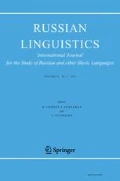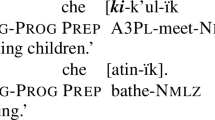Abstract
In recent years, two theories have been advocated in the syntactic literature with respect to case assignment mechanisms, and this paper tests them based on new empirical material from Russian. One theory, advocated by Woolford and others, is Inherent Case Theory (ICT), which views case as an overt reflection of a relationship between a given noun phrase and a (usually functional) head. The other theory, known as Dependent Case Theory (DCT) and advocated most recently by Baker and Bobaljik, views case as a reflection of a relationship between noun phrases in a given structural domain. In this paper, we test the two theories against the findings of two experimental studies conducted by us on eventive nominalizations in Russian. In such nominalizations, transitive / agentive subjects are marked by the instrumental, whereas objects / internal arguments are marked by the genitive. We call into question whether in these types of nominalizations, an agentive subject that is not accompanied by an internal argument that needs a case is marked by the instrumental (as predicted by ICT) or the genitive (as predicted by DCT). Having tested this in two experimental studies, we argue that only one of these theories, the ICT, can account for our empirical findings in a complete and coherent way.
Аннотация
В этой статье на новом эмприческом материале из русского языка тестируются две теории приписывания падежа, представленные в современной синтаксической литературе. Одна теория, связанная с именами Э. Вулфорд и других исследователей,—это теория ингерентного падежа, рассматривающая падеж как экспонент синтаксической связи между именной группой и некоторой (обычно функциональной) вершиной. Другая теория—теория зависимого падежа—отстаивается в недавних работах М. Бейкера и Дж. Бобальика; в этой теории падеж отражает соотношение именных групп в некоторой структурной области. В статье мы проводим эмпирическую проверку данных теорий, используя результаты проведенных нами экспериментальных исследований русских событийных номинализаций. В таких номинализациях переходные (агентивные) подлежащие маркируются инструменталисом, а дополнения / внутренние аргументы—генитивом. Мы задаемся вопросом, какое маркирование получает агентивный внешний аргумент в номинализации, где внутренний аргумент отсутствует либо не нуждается в структурном падеже. Теория ингерентного падежа предсказывает в таком случае инструменталис, теория зависимого падежа—генитив. На основе двух экспериментов мы показываем, что только теория ингерентного падежа может последовательно объяснить эмпирические данные русского языка.




Similar content being viewed by others
Notes
Pereltsvaig, A., Eventive Nominalizations in Russian and the DP / NP Debate. To appear in Linguistic Inquiry.
See also Rappaport, G. C., The Slavic noun phrase. Position paper presented at the Workshop on Comparative Slavic Morphosyntax, Indiana University, Bloomington, May 1998.
Cf. also Engelhardt, M., & Trugman, H., Double genitive constructions in Russian. Presented at the Workshop on Comparative Slavic Morphosyntax, Indiana University, Bloomington, May 1998.
Pereltsvaig, A., Nominalizations in Russian: argument structure, case, and the functional architecture of the noun phrase. Paper presented at the 6th Workshop on Nominalizations. Verona (Italy) 2015.
Similar examples from the RNC include the following:
-
(i)

-
(i)
-
(i)
Daže zimoj deduška plavaet v rečke každyj den’, xotja ežednevnoe plavanie deduškojinstr bespokoit vsju sem’ju.
‘Even in winter grandfather swims in the river every day, although daily swimming by grandfather worries the whole family.’
-
(i)
Kendall’s coefficient of concordance is usually used to measure agreement among experts’ judgments. In our analysis we applied it to the judgments for ENs that belong to the middle and ‘most acceptable’ bins with external arguments marked with INSTR. We counted the coefficient for each respondent as if each sentence in one EN type was evaluated by a distinct expert. This approach shows whether respondents judge the INSTR consistently: the higher the coefficient is, the less variance we find within one EN type.
Computation starts with \(k=2\) randomly selected observations that are assumed to be centers of clusters. Then clusters are created by associating every observation with the nearest center and by changing centers after each iteration in order to minimize variance within clusters and maximize variance between them. Variance is computed with respect to distinct parameters, which in our case are types of ENs.
This finding raises interesting methodological issues about experimental studies based on production vs. judgment, to be considered in future research.
References
Alexiadou, A. (2001). Functional structure in nominals. Nominalization and ergativity. Amsterdam, Philadelphia.
Apresjan, Ju. D. (1974). Leksičeskaja semantika. Sinonimičeskie sredstva jazyka. Moskva.
Babby, L. H. (1997). Nominalization in Russian. In W. Browne, E. Dornisch, N. Kondrashova, & D. Zec (Eds.), Formal Approaches to Slavic Linguistics (FASL-4). The Cornell Meeting 1995 (Michigan Slavic Materials, 39, pp. 54–83). Ann Arbor.
Bailyn, J. (2004). The case of Q. In O. Arnaudova, W. Browne, M. L. Rivero, & D. Stojanovic (Eds.), Formal Approaches to Slavic Linguistics (FASL-12). The Ottawa Meeting 2003 (Michigan Slavic Materials, 49, pp. 1–35). Ann Arbor.
Bailyn, J. F. (2012). The syntax of Russian. Cambridge.
Baker, M. C. (2012). On the relationship of object agreement and accusative case: evidence from Amharic. Linguistic Inquiry, 43(2), 255–274.
Baker, M. (2014). Types of cross-linguistic variation in case assignment. In M. C. Picallo (Ed.), Linguistic variation in the minimalist framework (pp. 36–60). Oxford.
Baker, M. C. (2015). Case. Its principles and its parameters (Cambridge Studies in Linguistics, 146). Cambridge.
Baker, M. C., & Bobaljik, J. D. (2017). On inherent and dependent theories of ergative case. In J. Coon, D. Massam, & L. D. Travis (Eds.), The Oxford handbook of ergativity (pp. 111–134). Oxford.
Bobaljik, J. D., & Wurmbrand, S. (2009). Case in GB / minimalism. In A. Malchukov & A. Spencer (Eds.), The Oxford handbook of case (pp. 44–58). Oxford.
Chomsky, N. (2000). Minimalist inquiries. The Framework. In R. Martin, D. Michaels, & J. Uriagereka (Eds.), Step by step. Essays on minimalist syntax in honor of Howard Lasnik (pp. 89–155). Cambridge.
Engelhardt, M., & Trugman, H. (1998). D as a source of adnominal genitive in Russian. In Ž. Bošković, S. Franks, & W. Synder (Eds.), Formal Approaches to Slavic Linguistics (FASL-6). The Connecticut Meeting 1997 (Michigan Slavic Materials, 43, pp. 114–133). Ann Arbor.
Grimshaw, J. (1990). Argument structure (Linguistic Inquiry Monographs, 18). Cambridge.
Koptjevskaja-Tamm, M. (1993). Nominalizations. London.
Koptjevskaja-Tamm, M. (2013). Action nominal constructions. In M. S. Dryer & M. Haspelmath (Eds.), The world atlas of language structures online. Retrieved from http://wals.info/chapter/62 (19 March 2018).
Levin, B. (1989). The Basque verbal inventory and configurationality. In L. Marácz & P. Muysken (Eds.), Configurationality. The typology of asymmetries (Studies in Generative Grammar, 34, pp. 39–62). Dordrecht.
Lyutikova, E. (2014). Russkij genitivnyj posessor i formal’nye modeli imennoj gruppy. In E. A. Ljutikova, A. V. Zimmerling, & M. B. Konošenko (Eds.), Tipologija morfosintaksičeskix parametrov. Materialy Meždunarodnoj Konferencii ‘Tipologija Morfosintaksičeskix Parametrov 2014’ (Vol. 1, pp. 120–145). Moskva.
Lyutikova, E. A. (2017). Formal’nye modeli padeža. Teorii i priloženija. Moskva.
Lyutikova, E., & Pereltsvaig, A. (2015a). The Tatar DP. Canadian Journal of Linguistics / Revue Canadienne de Linguistique, 60(3), 289–325. https://doi.org/10.1017/S0008413100026232.
Lyutikova, E., & Pereltsvaig, A. (2015b). Struktura imennoj gruppy v bezartiklevyx jazykax: universal’nost’ i variativnost’. Voprosy jazykoznanija, 3, 52–69.
Marantz, A. (1991). Case and licensing. In G. F. Westphal, B. Ao, & H.-R. Chae (Eds.), 8th Eastern States conference on linguistics (ESCOL ’91). Papers (pp. 234–253). Columbus.
Padučeva, E. V. (2009). Posessivy i imena sposoba dejstvija. In A. E. Kibrik et al. (Eds.), Komp’juternaja lingvistika i intellektual’nye texnologii. Po materialam ežegodnoj Meždunarodnoj konferencii «Dialog 2009» (Vol. 8(15), pp. 365–372). Moskva.
Pazel’skaja, A. G. (2006). Nasledovanie glagol’nyx kategorii imenami situacii: na materiale russkogo jazyka (Diss. kand. filol. nauk). Москва.
Pesetsky, D., & Torrego, E. (2001). T-to-C movement: causes and consequences. In M. Kenstowicz (Ed.), Ken Hale. A life in language (pp. 355–426). Cambridge.
Pesetsky, D., & Torrego, E. (2011). Case. In C. Boeckx (Ed.), The Oxford handbook of linguistic minimalism (pp. 52–72). Oxford.
Rappaport, G. C. (2000). Extraction from nominal phrases in Polish and the theory of determiners. Journal of Slavic Linguistics, 8(1/2), 159–198.
Rappaport, G. C. (2002). Numeral phrases in Russian: a minimalist approach. Journal of Slavic Linguistics, 10(1/2), 327–340.
Woolford, E. (1997). Four-way case systems: ergative, nominative, objective and accusative. Natural Language & Linguistic Theory, 15(1), 181–227.
Woolford, E. (2006). Lexical case, inherent case, and argument structure. Linguistic Inquiry, 37(1), 111–130.
Zaika, N. M. (2014). Lithuanian nominalizations and the case marking of their arguments. In A. Holvoet & N. Nau (Eds.), Argument realization in Baltic (Valency, Argument Realization and Grammatical Relations in Baltic, 3, pp. 523–550). Amsterdam, Philadelphia.
Author information
Authors and Affiliations
Corresponding author
Additional information
This work has benefited greatly from discussions with (in alphabetical order) M. Teresa Espinal, Olga Fedorova, Boris Harizanov, Elena Ilyushina, Ora Matushansky, and Roberto Zamparelli. We are also grateful to all the native speakers who participated in our experimental studies. This research is supported by a grant from Russian Science Foundation (project # 16-18-02003 ‘Structure of meaning and its mapping into lexical and functional categories of Russian’ at MPSU).
Rights and permissions
About this article
Cite this article
Pereltsvaig, A., Lyutikova, E. & Gerasimova, A. Case marking in Russian eventive nominalizations: inherent vs. dependent case theory. Russ Linguist 42, 221–236 (2018). https://doi.org/10.1007/s11185-018-9196-6
Published:
Issue Date:
DOI: https://doi.org/10.1007/s11185-018-9196-6





